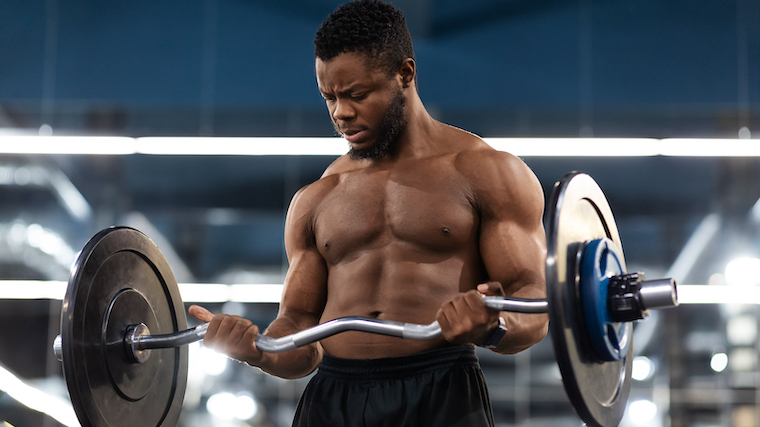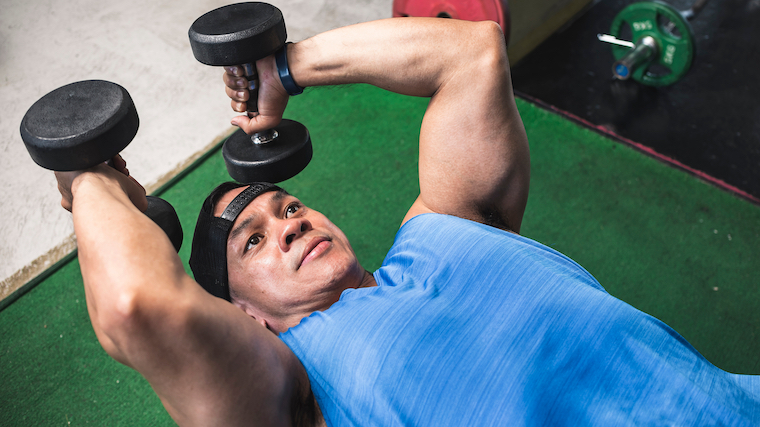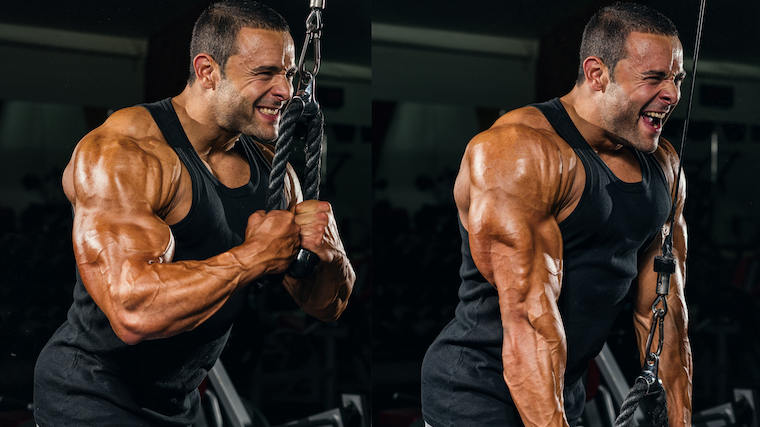Should powerlifters perform arm-focused training? The short answer is yes. The long answer is an absolute yes.
Many fitness gurus in the powerlifting space might claim that direct arm work is overrated; arms get plenty of strength and size gains from presses and rows, presuming the overall routine is sound. That is only partially true. Arms will grow from those movements alone, but if that’s all athletes do, they will still look disproportionately small, barring fantastic genetics for big arms. They’ll probably be disproportionately weak, too. That means your bench press lockout may end up weaker than it should.
If your current training regimen includes a high volume of presses and rows (which it should), then you may not need as much direct arm work for sufficient size and strength. However, if your training doesn’t include focused arm training, even a little bit can go a long way when implementing smart programming and performing the movements properly.

[Related: What You Need to Know About How to Increase Strength]
How to Add Direct Arm Work to Your Training
When first adding arm work to any program, it’s important to start slow. Arm work can put a lot of stress on the elbows, which are smaller joints that tend to be vulnerable to tendonitis or other injuries. Follow these two rules:
- Avoid training biceps or triceps isolation movements, such as curls and extensions with hefty weights. Instead, stick to lighter weights and higher reps. Focus on the volume and intensity rather than the amount of weight.
- Avoid marathon sessions for the arms. Shorter, more frequent training will allow for plenty of arm work without overloading them in a single session.
These recommendations are beneficial for more than just avoiding injury. Lighter reps and higher reps are a great way to get a great pump, and in terms of arm size, the pump is pretty important. A 2019 study in Frontiers in Physiology found that achieving muscle pump led to “greater biceps” with less total training volume than simple resistance training that doesn’t involve getting a pump. (1)
Additionally, achieving a pump leads to more gains in less total training time. So programming shorter, more frequent arm training sessions will allow for direct arm work without detracting from squat, bench press, and deadlift training as much as longer sessions might.

[Related: Build Muscle and Lose Body Fat With Calisthenics Training]
How Much and What Type of Direct Arm Work to Include
How much is too much arm training? There isn’t a hard-and-fast blanket rule because everyone’s training needs are different. It depends heavily on how much compound work is programmed for the back, chest, and shoulders. For most people, four to six working sets of biceps isolation and six to eight working sets of triceps isolation (all for high reps of at least 10 to 12, if not more) per session should suffice.
As far as the type of movements to incorporate, it’s important to consider your goals and weaknesses. Bodybuilders need to focus on overall size and shape, which often zones in on the long head of the triceps, and a lot of brachialis work with movements like skull crushers and hammer curls. The long head of the triceps is a key muscle displayed during side poses and the building of the brachialis improves muscle thickness. Bigger triceps means a stronger bench press for powerlifters, and stronger biceps will naturally lead to strengthened forearms. Some examples include the Tate press and reverse-grip thick bar curls.
[Related: RPE Vs. Percentage-Based Training Explained]
The exact movements don’t matter as much as the ability to load them progressively. Even with lighter training and isolation exercises, progressive overload is essential to progress in the long term. Progressive training doesn’t necessarily mean using more weight: for example, you can use the same weight and crank out more reps, or you can cut down on your rest between sets from workout to workout. But for that to work, you’ll need to use exercises that you can train hard (so probably avoid dumbbell kickbacks) without causing any pain or overuse injuries.
Arm Exercises For Powerlifters
Below is a list of movement options to train the triceps and biceps and a sample workout to program into your training routine:
Triceps Focused
- Overhead dumbbell extensions
- Rolling dumbbell extensions
- Skull crushers
- Reverse-grip cable pushdowns
- Tate presses
Biceps Focused
- Cross-body hammer curls
- Barbell curls
- Reverse-grip thick bar curls
- Spider curls (barbell or dumbbell)
- Machine curls

[Related: How to Incorporate Bands and Chains Into Your Weight Training]
Sample Arm-Training Workout for Powerlifters
This routine can be used by almost anyone, but be careful not to change up your routine too much all at once. It can be very tempting to add more, more, and more, but too much can be detrimental when it comes to arm training.
Day One — After Heavy Bench
- Reverse-Grip Band Pushdown — 20 reps
- Focus on only the bottom end of the range of motion
- Keep your elbows turned out
- Don’t go to failure — treat it more as a warmup or pre-exhaust
- Triset with…
- Hammer Curl — 10-12 reps
- Triset with…
- Rolling Dumbbell Extension — 10-12 reps
Rest three minutes. Repeat for four total supersets.
Day Two — After Light Bench
- Reverse-Grip Band Curl — 20 reps
- Use as a warmup or pre-exhaust
- Superset with…
- Thick-Handle Concentration Curl — 10-12 reps
Rest two minutes. Repeat this for two total supersets. Then do:
- Tate Press — 12-15 reps, three sets
- Rest two minutes between sets
- Overhead Cable Extension — Three sets with rep scheme 20, 15, 12
- Rest one minute between sets
Build Those Arms
That routine will not only add some decent size to your upper arms, but it will protect your elbows so you can continue to train hard and earn those gains. Make these additions to your training regimen slowly and the dividends earned in your increased bench press will be plentiful.
References
- Fernando Noronha de Almeida, et al. Acute Effects of the New Method Sarcoplasma Stimulating Training Versus Traditional Resistance Training on Total Training Volume, Lactate and Muscle Thickness. 2019. Frontiers in Physiology. doi: 10.3389/fphys.2019.00579.
Featured Image: Shutterstock/Prostock-studio